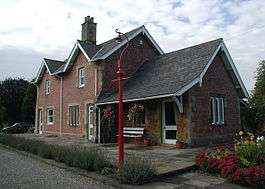Stutton, North Yorkshire
| Stutton | |
 Stutton |
|
| Population | 983 (2011)[1] |
|---|---|
| OS grid reference | SE479414 |
| Civil parish | Stutton with Hazlewood |
| District | Selby |
| Shire county | North Yorkshire |
| Region | Yorkshire and the Humber |
| Country | England |
| Sovereign state | United Kingdom |
| Post town | TADCASTER |
| Postcode district | LS24 |
| Dialling code | 01937 |
| Police | North Yorkshire |
| Fire | North Yorkshire |
| Ambulance | Yorkshire |
| EU Parliament | Yorkshire and the Humber |
| UK Parliament | Selby and Ainsty |
Coordinates: 53°52′N 1°16′W / 53.87°N 1.27°W
Stutton is a small village in the Selby district of North Yorkshire, England, a mile southwest of Tadcaster.

It lies in the valley of the Cock Beck which discharges into the River Wharfe one mile to the east of the village. It is in the parliamentary constituency of Selby, the civil parish of Stutton-cum-Hazlewood and ecclesiastical parish of Tadcaster.
It has an ancient history, likely founded by a Viking settler named Stufi in the late 9th century. By the time of William the Conqueror’s Domesday survey in 1086 it had a mill, meadow and woodland along with a number of villagers. It remained a small hamlet until major residential development occurred in the 1960s and 70s.
From Norman times until 1907/8 a substantial part of the village was owned by the Vavasour family of Hazlewood Castle as part of the Stutton-cum-Hazlewood estate. The castle is now a prestigious hotel.
The district close to the village is famous for the milk white magnesium limestone quarried since Roman times and used in the construction of York Minster and much local property. The most famous quarry “Jack Daw” is located ½ mile to the west.
Traditionally villagers would make a living working in agriculture on the productive soils which overlie the limestone. The marshy area in the village close to the Cock Beck contained many willow groves and willow harvesting, drying and stripping was a cottage industry until the 1930s. The long straight willow stems were used for basket making.
A railway line was authorized by Act of Parliament between Harrogate and Church Fenton in July 1845 to the York and North Midland Railway Company, later becoming the North Eastern Railway. The route of the line passed through Stutton and a station and goods yard was built. Construction took place between 1845 and 1847 with the line opening from Church Fenton to Spofforth including Stutton on 10 August 1847 and Harrogate on 20 July 1848.
The station building is Tudor style, two stored, brick with sandstone edging. It was designed by the famous railway architect George Townsend Andrews (1804–1855). Andrews was a close associate of George Hudson the York railway ‘King’ who was a one-time sheriff of York but later disgraced due to fraudulent business practices. Andrews designed many high-quality stations in the north-east and favoured classical and Gothic styles.
Passenger traffic at Stutton station was never commercially successful due to the small size of the village and proximity to Tadcaster Station. Some effort was made post 1847 in the village to stimulate development and roads were moved and building sized plots laid out but most were not taken. The station closed to passenger traffic on 30 June 1905, although occasional holiday charters continued to call at the Station until the 1960s.
Railway staff continued to occupy the building to work the adjacent level crossing over the road Weeding Gate and the signal box built of wood at the northern end of the property. The signal box was demolished in the late 1960s.
The civil Parish Council of Stutton-cum-Hazlewood met in the waiting room of the building from the 22 May 1908 (and likely before) until 4 February 1960 when it transferred to the then new Stutton Village Hall. The building was also used as the local polling station.
On 4 January 1964 the whole line was closed to passenger traffic and on 2 April 1966 closed to goods traffic and the track lifted as part of the Beeching era railway closures.
In 1970 the British Railways board put the Station building up for sale and, after some time, it was sold and sympathetically converted into a private house.
In 1900 the village had a water mill, railway station and goods yard, blacksmiths workshop, large purpose built malting building, two shops, C of E mission church, a public house and a collection of ancient limestone built houses.
Today, the village has a public house the Hare and Hounds, owned by Samuel Smith Brewery, about 70 houses, mostly modern, but with at least 1 dating back to 1697 (Manor House Farm), and a small village hall. St Aidan's, a small C of E Church, was a prominent feature in the village until its deconsecration in the early 2000s, although the building and stained glass window remain. Other amenities are located in the neighbouring town of Tadcaster.
Just southwest of Stutton is Wingate Hill, the site of the Saxon court for the West Riding. (Stutton was historically in the West Riding of Yorkshire.)
References
- ↑ "Civil Parish population 2011". Retrieved 16 August 2015.
External links
| Wikimedia Commons has media related to Stutton, North Yorkshire. |